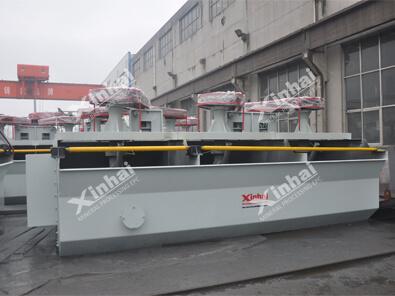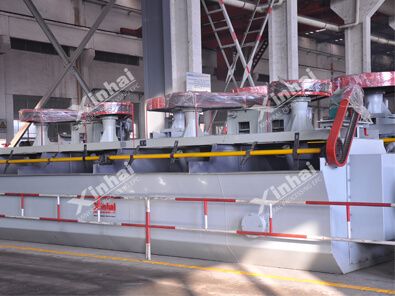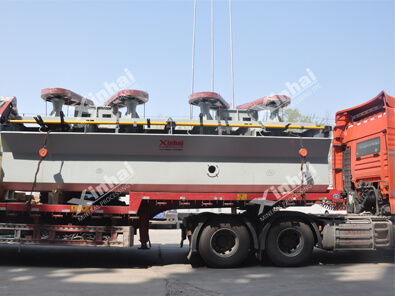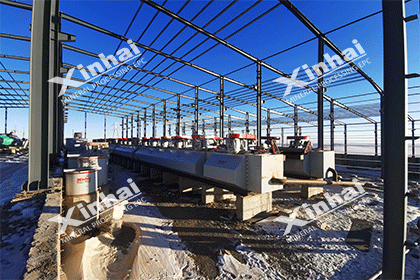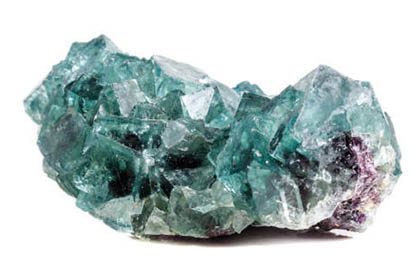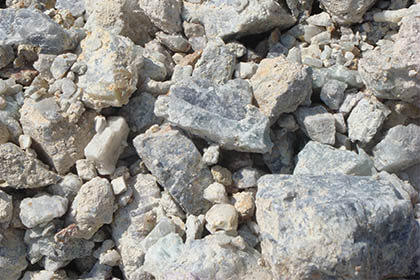How to Extract Fluorite From Ore?
 Shirley
Shirley
 Nov 29, 2023
Nov 29, 2023
 1351
1351
If you want to know more details about equipment, solutions, etc, please click the button below for free consultation, or leave your requirements!
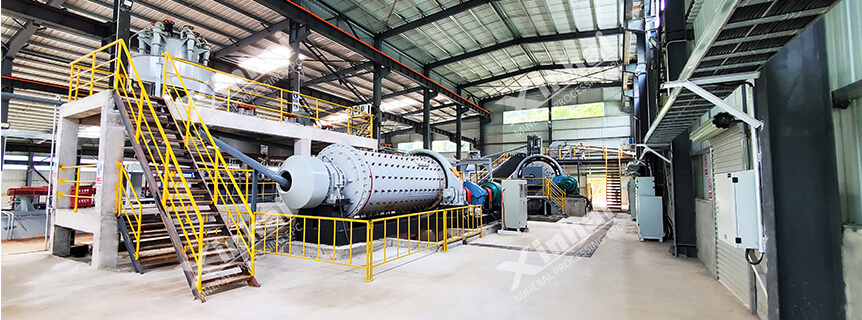
According to the different gangue minerals, fluorite ore can be divided into four types, namely quartz-type fluorite ore, calcite-type fluorite ore, barite-type fluorite ore and sulfide-type fluorite ore. Currently, there are three main fluorite ore beneficiation processes: hand separation, gravity (jigging) beneficiation, and flotation. In view of the depletion of fluorite raw ore and the inter-embedded characteristics of fluorite and gangue, flotation is currently mainly used as the main beneficiation method to separate fluorite and gangue minerals.
01Quartz-Fluorite Ore Flotation Process
BackQuartz-type fluorite ore is mainly composed of fluorite (content up to about 85%) and quartz, with only a small amount of calcite, barite and sulfide present. The key to sorting is mainly to reduce silicon in the concentrate. To separate quartz from fluorspar, quartz and fluorspar monomers must be dissociated through grinding, so grinding is an important factor affecting quartz-type fluorspar flotation.
In production, quartz-fluorite ores are mostly rough-selected by grinding once, and the coarse concentrate is ground again for multiple selections. The pharmaceutical system often uses sodium carbonate as an adjuster to make it alkaline to prevent excessive amounts of water in the water. For the activation effect of valence cations on quartz, when using fatty acids as collectors, add an appropriate amount of water glass to inhibit silicate gangue minerals, and at the same time control the amount of water glass (a small amount will activate fluorite, and an excessive amount of fluorite will will be suppressed).
According to the embedded characteristics of useful minerals, quartz-fluorite ores can be mainly divided into two types: coarse-grained and fine-grained. The two types are different in the flotation separation process.
Coarse-grained fluorspar is easy to select. It uses fatty acid collectors, slurry adjuster is sodium carbonate, and quartz inhibitor is water glass. High-quality fluorspar concentrate can be obtained through a coarse polyconcentration process. The flotation reagents for fine-grained quartz-type fluorite ore are the same as those for coarse-grained quartz-type fluorite ore. However, since the particle size of the target mineral is finer, it is necessary to strengthen the grinding and use stage grinding and stage separation process flow.
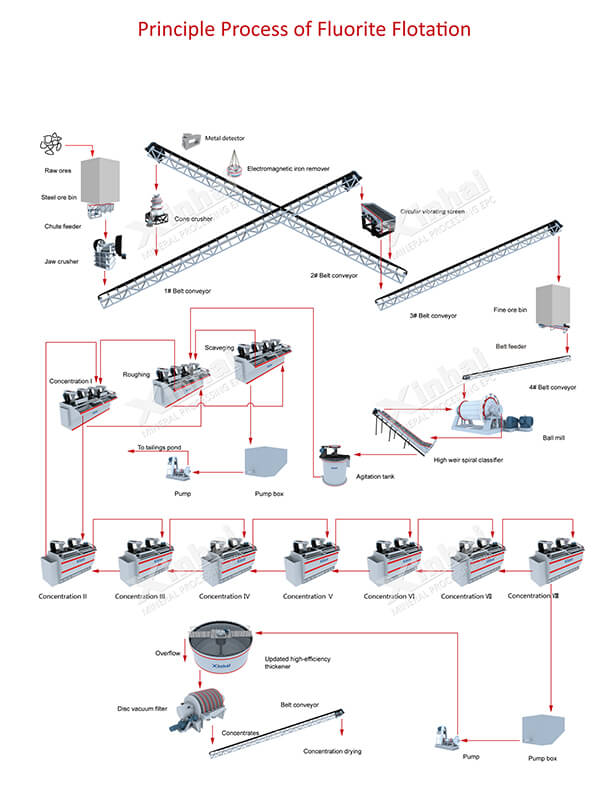
02Calcite-Fluorite Ore Flotation Process
BackThe main minerals of calcite-fluorite type ore are fluorite and calcite (content is as high as 30% or more), and some contain a small amount of quartz. Sometimes quartz-calcite-fluorite type ore can be formed, which is a difficult ore to be separated.
The main reason why this type of ore is difficult to separate is that calcite and fluorite are both calcium-containing minerals with similar surface physical and chemical properties. When they coexist in solution, mutual transformation between minerals is easy to occur. Choose appropriate collectors and inhibitors. It is the key to achieve the separation of fluorite and calcite.
To achieve the separation of calcite and fluorite, the pH value of the slurry must be adjusted and a collector must be used to achieve a good separation effect. When the pH value is 8 to 9.5, water glass, acidified water glass, sodium hexametaphosphate, lignosulfonate, dextrin, tannin, etc. are used alone or in combination to inhibit calcite, thereby achieving the purpose of separation. In addition, for complex fluorite ores containing more calcite, limestone, dolomite, etc., tannins and lignosulfonate can be used to suppress gangue minerals, and their flotation separation effect is better.
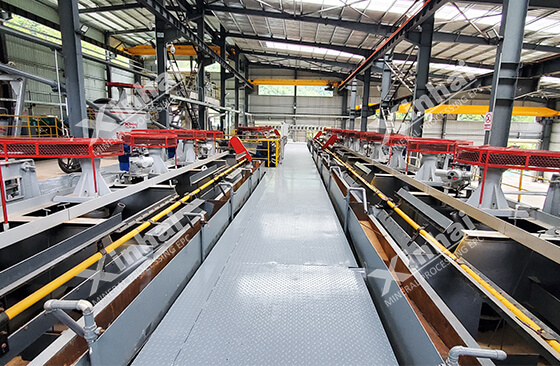
03Barite-Fluorite Ore Flotation Process
BackThe main minerals of barite-type fluorite ore are barite and fluorite. The barite content is generally 10%-40%, often accompanied by sulfide minerals such as pyrite, galena, and sphalerite.
This type of ore beneficiation is generally first mixed and flotated to obtain a barite-fluorite mixed concentrate, and then barite and fluorite are separated. According to the order in which barite and fluorite float out, it can be divided into two schemes: one is to suppress barite and float fluorite. This method can obtain high-grade barite concentrate and fluorite concentrate. The other is to inhibit fluorite flotation from barite. This method first obtains barite concentrate, then adds fatty acid collectors and sodium silicate to the tailings, and selects it multiple times (7 to 9 times) to obtain fluorite. Stone concentrate, this method has a simple process and is easy to operate, and can obtain qualified barite concentrate, but the grade of fluorite is often not high.
In actual production, the separation of fluorite and barite mostly adopts the process of inhibiting barite with floating fluorite, using fatty acid flotation agents as fluorite collectors, caustic starch, dextrin and other organic inhibitors combined with hexametaphosphoric acid Sodium, sodium fluorosilicate, water glass, aluminum salt, iron salt and other inorganic inhibitors are used in combination to achieve the purpose of separating fluorite and barite.
04Sulfide Fluorite Ore Flotation Process
BackIn actual production, the ore beneficiation technology for sulfide fluorspar-type ores is mainly based on flotation. The sulfide ores are first floated out with xanthate collectors, and the flotation tailings of fluorite are treated separately as fluorspar ore. Fatty acid-based agents are selected multiple times. Sometimes, in fluorspar flotation operations, a small amount of sulfide ore inhibitors (such as cyanide) are added to suppress residual sulfide to ensure the quality of fluorspar concentrate.
05To Wrap Up
BackIn addition, mineral processing technologies such as roasting and leaching can also be used to extract valuable metals and decompose fluorspar. The process flow is relatively simple and can produce high-quality fluorspar products while comprehensively recycling valuable metals.
 +86 183 3575 8886
+86 183 3575 8886 pinklaurabao@gmail.com
pinklaurabao@gmail.com




 Message
Message Chat Now
Chat Now


